Mountain God Kula Khari
Tibet 19th centuryMountain God Kula Khari; Tibet; 19th century; painted terracotta; 9-7/8 × 8¼ × 4-5/8 in. (25.1 × 21 × 11.7 cm); Rubin Museum of Art; C2002.7.3 (HAR 65079)
The Mountain Palace of a Worldly Divinity
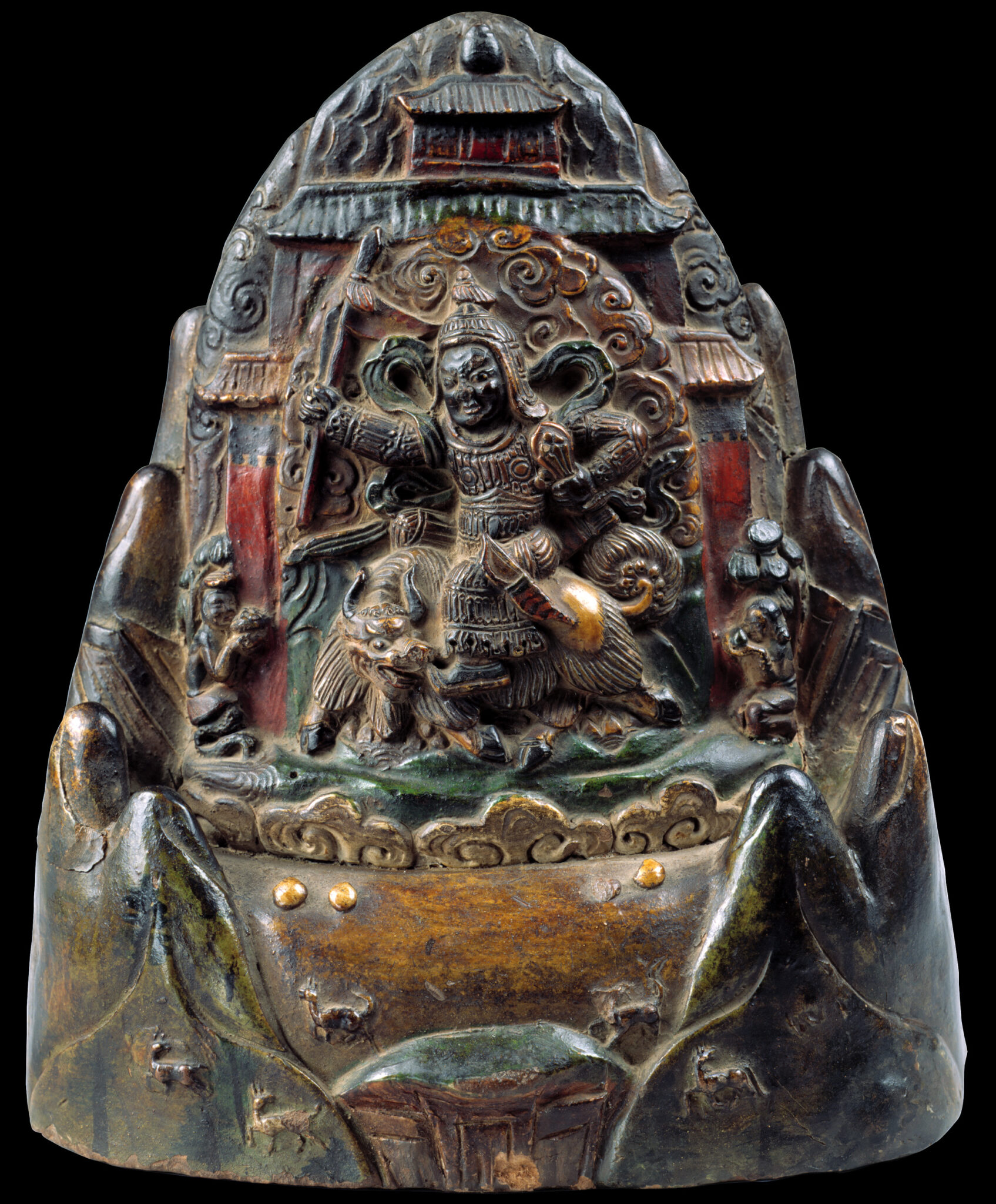
Mountain God Kula Khari; Tibet; 19th century; painted terracotta; 9-7/8 × 8¼ × 4-5/8 in. (25.1 × 21 × 11.7 cm); Rubin Museum of Art; C2002.7.3 (HAR 65079)
Mountain God Kula Khari; Tibet; 19th century; painted terracotta; 9-7/8 × 8¼ × 4-5/8 in. (25.1 × 21 × 11.7 cm); Rubin Museum of Art; C2002.7.3 (HAR 65079)
Some mountains are imagined as the mandala-palaces of enlightened Bon or Buddhist deities. Other mountains are abodes of ferocious local gods that have been tamed by tantric masters like Padmasambhava and bound to serve Buddhism. These gods grant prosperity to the land below, and pilgrims collect soil from their mountains and make images of them and replicas of the natural sites they inhabit for this purpose. Anthropologist Charles Ramble introduces the mountain gods of the Himalayas, warrior-kings of the natural world that have been revered since before the arrival of Buddhism.
Bon is an indigenous religion of Tibet. Originally, Bon were a group of non-Buddhist ritual specialists in the court of the Tibetan emperors. From the eleventh century onward, an organized religion called Yungdrung Bon, or “Eternal Bon,” took shape. Yungdrung Bon developed in dialogue with Buddhism, incorporating deities called buddhas, scriptures modeled on the Buddhist canon, monks, and the establishment of monasteries. Followers of Yungdrung Bon trace their own origins to a founder called Tonpa Shenrab, who arrived from the semi-mythical land of Zhangzhung in western Tibet. The word “Bon” can also refer to the many non-organized indigenous religious practices, including the worship of mountain deities and making namkha. A follower of Bon is called a Bonpo.
The Copper-Colored Mountain (Zangdok Pelri) is said to be the dwelling place or mandala-palace of the legendary Vajrayana master Padmasambhava. This mountain-palace is depicted in many thangkas and constructed as temples and portable shrines used by manipa itinerant storytellers.
Kailash is a mountain in far western Tibet. Tibetans call this mountain Kang Rinpoche (“Jewel of the Snows”). The rivers Indus, Sutlej, Brahmaputra, and Karnali all have their sources in the immediate area of this mountain. Among Hindus, Kailash is considered the abode of Shiva. Among Buddhists, Kailash is considered the site of Mount Meru on earth. Jains and Sikhs also consider the mountain sacred, and tens of thousands of pilgrims travel there every year to circumambulate the mountain. Mount Kailash is also an important sacred site for the Bon religion.
In many Himalayan and Inner Asian cultures some mountains and other natural forces are personified as gods, and mountains are places where gods reside. Tibetans understand some mountains to be mandala-palaces of Bon or Buddhist deities. Other mountains are the homes of fierce warrior-gods who have been tamed and bound by oath to protect Buddhism and the land, for instance Kula Khari, who have the power to harm or grant prosperity to local communities.
Historically, Tibetan Buddhism refers to those Buddhist traditions that use Tibetan as a ritual language. It is practiced in Tibet, Mongolia, Bhutan, Ladakh, and among certain groups in Nepal, China, and Russia and has an international following. Buddhism was introduced to Tibet in two waves, first when rulers of the Tibetan Empire (seventh to ninth centuries CE), embraced the Buddhist faith as their state religion, and during the second diffusion (late tenth through thirteenth centuries), when monks and translators brought in Buddhist culture from India, Nepal, and Central Asia. As a result, the entire Buddhist canon was translated into Tibetan, and monasteries grew to become centers of intellectual, cultural, and political power. From the end of the twelfth century, Tibetans were exporting their own Buddhist traditions abroad. Tibetan Buddhism integrates Mahayana teachings with the esoteric practices of Vajrayana, and includes those developed in Tibet, such as Dzogchen, as well as indigenous Tibetan religious practices focused on local gods. Historically major traditions of Tibetan Buddhism are Nyingma, Kagyu, Sakya, and Geluk.
stands just north of the border between Bhutan and Tibet, rising above surrounding peaks to a majestic 24,731 feet (7,538 meters) above sea level. The sculpture featured here would have been set on the altar of a shrine room in a private house, or perhaps in a temple. Such replicas of natural sites are widespread in : an image of another such sculpture, which appears below, represents (fig. 2).
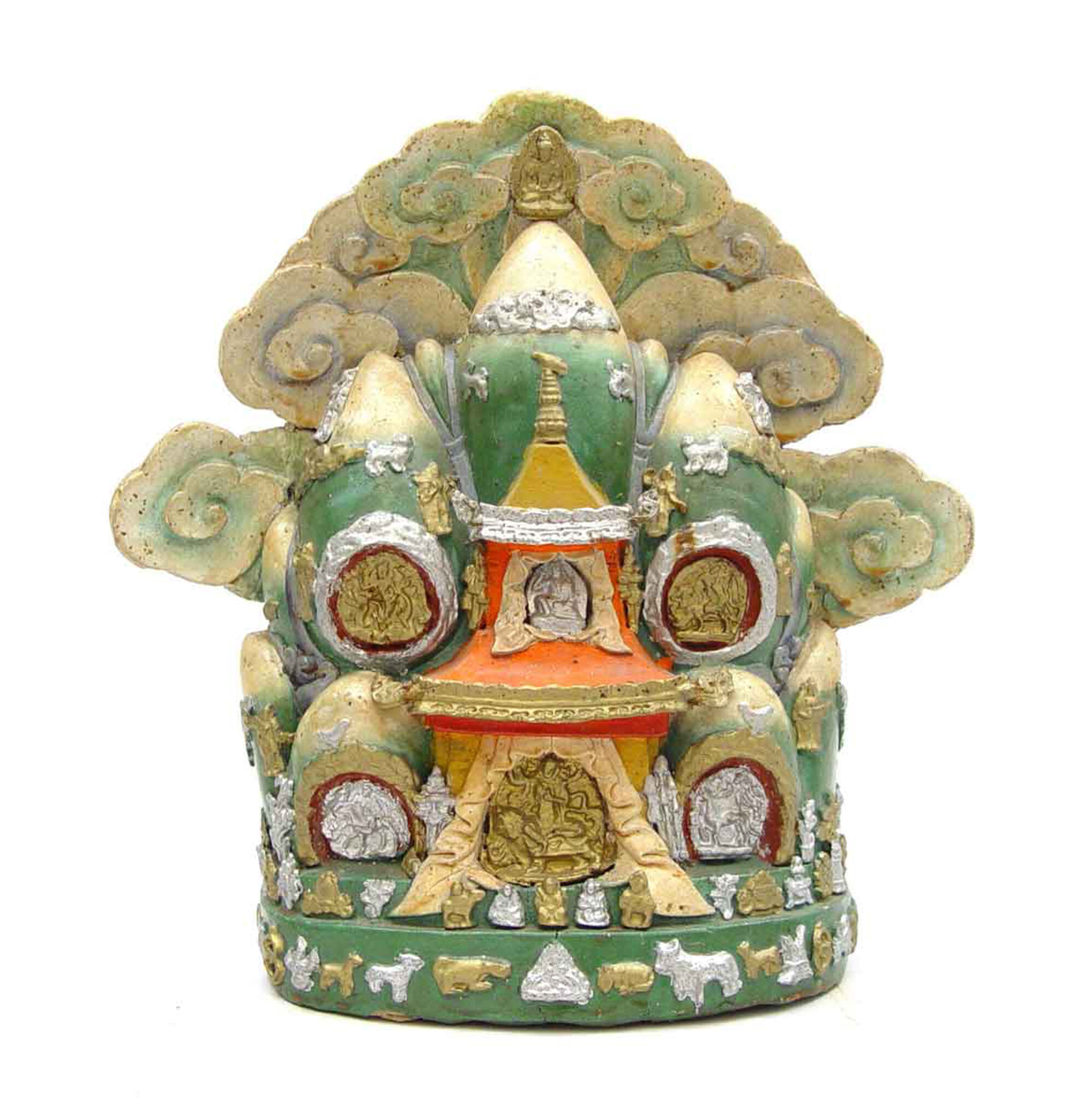
Icon of the Five Auspicious Long Life Sisters; Bhutan; date unknown; clay; 12-1/8 × 12¼ × 3/8 in. (30.8 × 31 × 0.8 cm); Ethnographic Museum at the University of Zurich; inv. no. 20681; photograph by Tashi Brauen
Portable representations of sacred sites are well known in other parts of the world, too. During the Liao Empire (907–1125) miniature stone replicas of the at the Eight Great Sites of India were assembled in China as a virtual pilgrimage of the Holy Land of . In the Christian world, from late antiquity on, images of Jerusalem’s Holy Sepulchre were depicted on metal ampullae containing sacred oil. Tibetans who go on pilgrimage generally return with whatever substances the sites they visit are known for—water from Lake Manasarovar, or small stones from Pretapuri—which they place on their shrines and give to friends and family. These substances are fragments of the place that embody the whole—pars pro toto. Miniatures also represent the original, not as fragments but as scaled-down holograms. It is possible to combine the two ideas: scroll paintings () of often bear the imprints of their hands and/or feet (examples of such thangkas can be found here: 1, 2, 3); the ampullae decorated with images of the Holy Sepulchre contained sacred oil from the temple; and an image of a mountain may contain earth collected from its vicinity.
There is one obvious difference between the Mahabodhi Temple and the Holy Sepulchre on the one hand and Kula Khari on the other: The first two are manmade monuments, while Kula Khari is a natural feature. In fact, natural sites are often considered holy places by Tibetans and form major nodes in the itineraries of pilgrims. Such mountains, known as neri in Tibetan, are envisaged as of the great tantric divinities. They often feature in thangkas and block prints. Examples include Mount (shown in this painting) in Tibet, Mount in China, and , the most sacred mountain for the Bonpos, located in southeastern Tibet. This mountain is seen as a mandala of the Bonpo divinity Tsochok Khagying (fig. 3). Another common candidate for depiction is Zangdok Pelri, the of the Buddhist saint Padmasambhava: that mountain is located in a mythical land, but certain earthly mountains, notably in Nepal, are revered as its terrestrial manifestations.
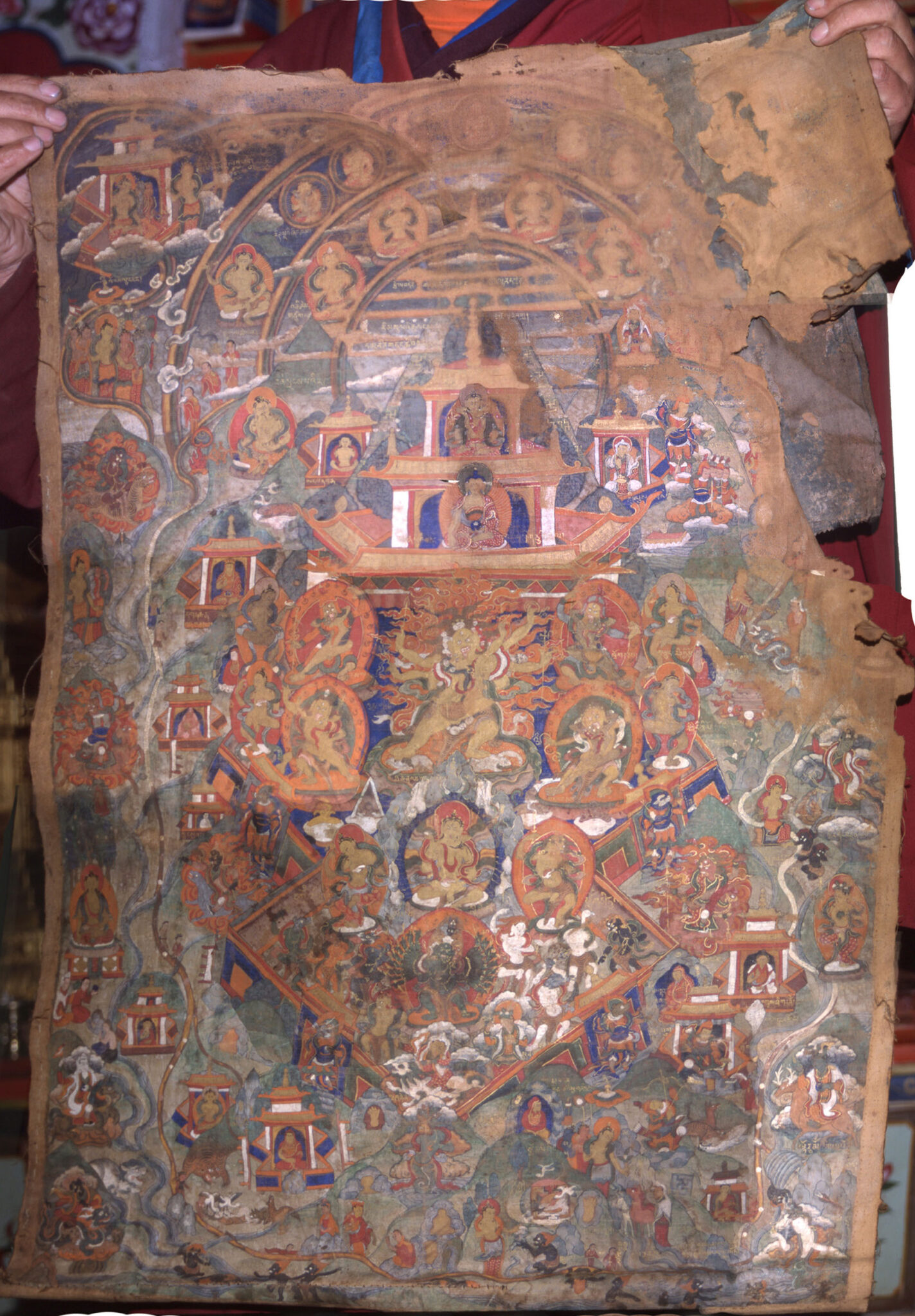
Thangka of Kongpo Bonri, southeast Tibet, represented as the citadel of the tantric divinity; Tsochok Khagying, Nyingtri, Kongpo, Tibet; 18th century?; cotton, mineral pigments; dimensions unknown; photograph by Pasang Wangdu
The main factors that distinguish Kula Khari from these mountains are that it is not the abode of an enlightened divinity, and it is not represented as a mandala. Kula Khari is a mountain god of the kind that are believed to have sworn an oath to protect Buddhism. In the context of the establishment of Buddhism in the country, Tibetan uses the term dulwa, which has a wide semantic range analagous to the English “pacify”: it may denote the transformation of wilderness into farmland, or the gentle guidance of the ignorant to virtuous ways, or the forceful subjugation of humans or demons that might offer resistance to political or religious expansion. In the dominant conversion narrative, the gods of Tibet were coerced by into promising to serve the doctrine, and have henceforth been known as damchen, “oath-bound.” Territorial gods may be the object of two quite different cults: they may be revered for their native power, either as solitary local gods or as members of a group; alternatively—or additionally—they may be venerated as minor Buddhist protectors in the entourage of a tantric divinity.
Historically, tantric divinities are projected onto the landscape by lamas who record their visions in pilgrimage guides. These works are both descriptive and prescriptive, presenting the historical and topographical aspects of the place, but also specifying the activities pilgrims should perform there, and explaining how a terrain should be perceived. Seen with such spiritual clarity, a mountain is presented as a stupa or citadel at the center of a mandala with a tantric divinity at its heart, and this vision becomes the dominant scheme for observant Buddhists or Bonpos.
In the case of Kula Khari (fig. 4), this transformation has not taken place. Center stage in the sculpture (fig. 1) is occupied by a divinity framed by his mansion, but the mountain is a mountain, not a mandala, and there are natural features such as rocks, clouds, a lake, and meadows with frolicking deer.
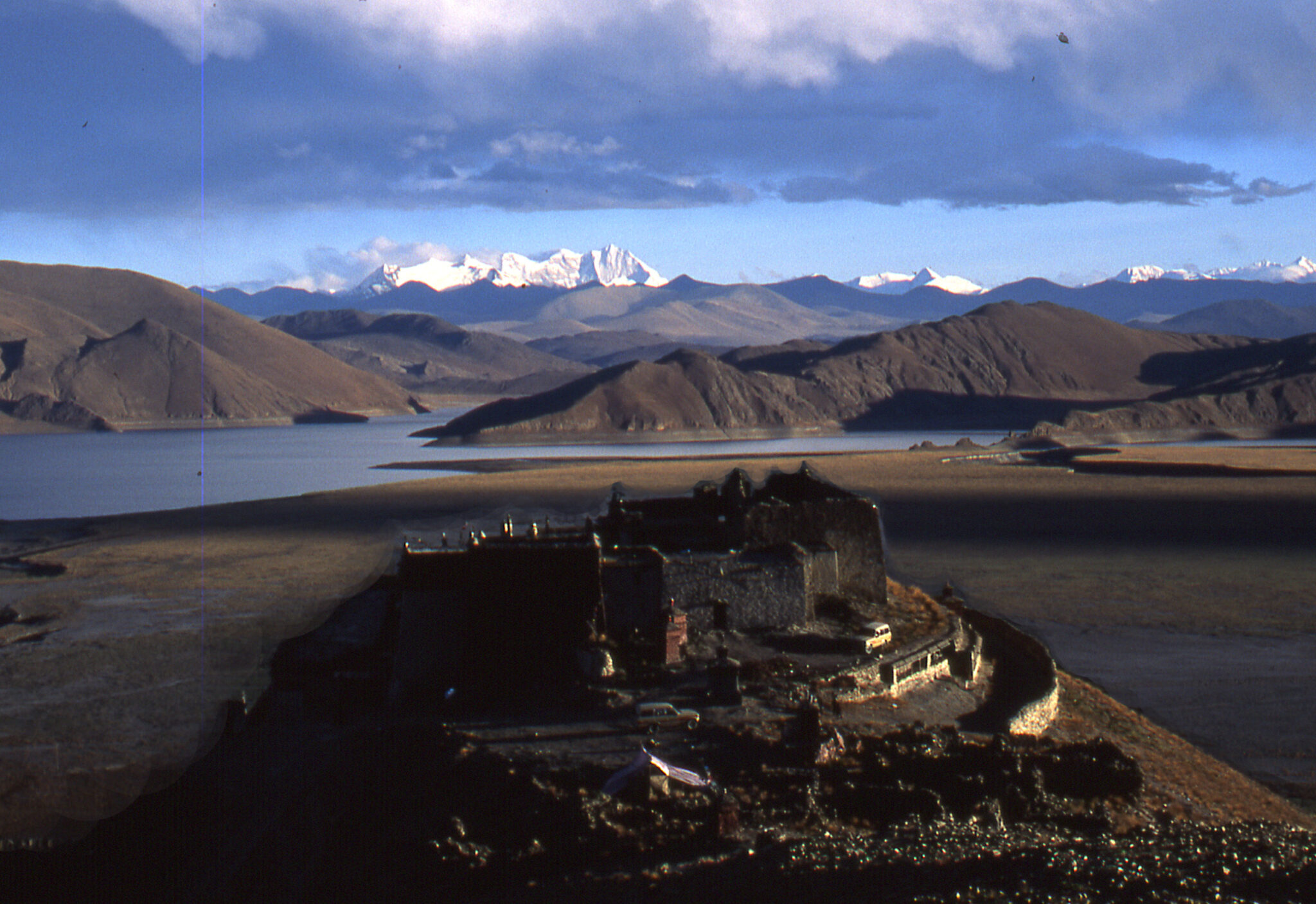
The following is a paraphrase of part of a prayer to Khari:
His father was Gangri Gauje, the king of Sheu in Lhoto, and his mother Menchen Pura Changmo. He has the body of a great crystal snow-mountain, with the sun and moon at its peak, clouds swirling around it, and a lake below. Surrounded with a fiery rainbow spitting sparks, he wears a white cloak, white armor, a crystal helmet with white silk pennants. In his right hand he holds a crystal spear, and in his left a receptacle for imprisoning enemies. His mount is a flying horse, with a crystal saddle, golden armor, and a turquoise harness, that takes the form of a crystal yak bestriding earth and sky. He is accompanied by myriad riders wearing quivers and brandishing weapons. His consort is Chammo Shelza (Crystal Lady), who belongs to the men class of goddesses. Adorned with jewelry and gold, she holds a conch-shell parasol, and rides a flying dzo (yak-cow crossbreed). She sits on a brocade saddle, wearing a white dress like a goddess, with a magical mirror on her head, and she leads a female deer decorated with jewelry.
Descriptions such as these vary. For example, the attributes Khari holds are not always the same, and his consort—who goes by different names—sometimes rides the deer and leads the dzo.
Kula Khari was subjugated when Padmasambhava summoned all the powers of Tibet before him at , north of Lhasa (fig. 5). One account maintains that Padmasambhava repeated this exercise from a temple that had been built by Emperor Songtsen Gampo (ca. 605–649) in what would later become Bhutan. The Bhutanese saint Pema Lingpa (1450–1521) recounts an episode at a where he was staying in southern Tibet. In this story, he receives a visit from an old man riding a white wolf, who invites him on a journey. Pema Lingpa is borne away to a mansion on the heights of Kula Khari, where the old man reveals that he is none other than the mountain god Khari himself. Pema Lingpa is then invited to the roof of the mansion, from where he is shown various sacred mountains and paradises.
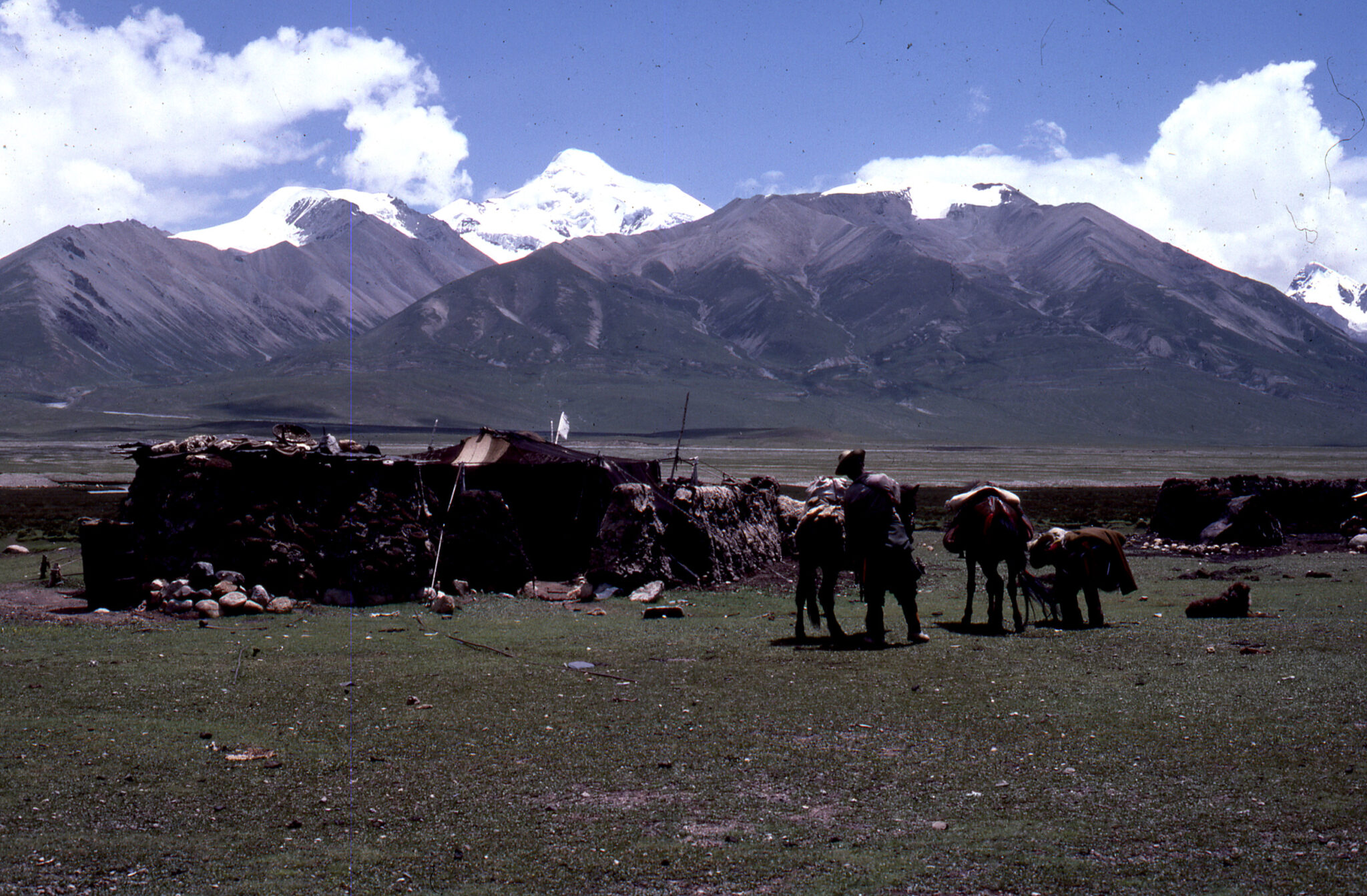
Nomad Camp, foot of Mount Nyenchen Thangla, north of Lhasa, Tibet; photograph by Charles Ramble
Kula Khari’s association with mountains is explicit in the second part of his name, Khari, “Sky Mountain,” and some texts identify him as the southernmost member of a quartet of , the others being Yarlha Shampo (east), Nojin Gangzang (west). and Nyenchen Tanglha (north).
Mounts Kula Khari, Yrlha Shampo, Nojin Gangzang and Nyenchen Tanglha.
The first part of his name, Kula, has been the subject of lively debate. The name has two forms, kulha and kubla, both pronounced indistinguishably as kula in modern Tibetan dialects. Ku is an honorific term for “body,” while lha and bla mean respectively “god” and “soul.” In early Tibet, the original form of kubla may have been kulha, but after imperial times the term reverted to kulha and acquired a different meaning. The kubla had been the divine manifestation of the Tibetan emperor; there was only one (though other realms had their own), and it is uncertain whether there was any association with a specific mountain. In postimperial times, the term kubla may have acquired a new form, gurlha, the title of a group of thirteen gods. The term kulha, corresponding to the usual spelling of Kula, came to be associated with mountain gods. However, the distinction between gurlha and kulha is blurred in later Tibetan sources: one list of gurlha in a Bonpo text includes the name Shewu Kharing, a clear reference to Kula Khari, Shewu being a toponym that is often attached to his name. According to a recent compilation, as Shewu Khari he is also one of the “The Nine Gods of the Coming into Being of the Phenomenal World,” composed of the ancient god Wode Gunggyel and his eight sons, and one of twenty-one gods who took lay-follower’s vows from Padmasambhava. While invocations to Khari habitually remind him of the oath he swore to protect the doctrine and to destroy its enemies, he is also associated with well-being. Among the people of the Tibet-Bhutan borderland who live in his vicinity, Khari features (as Kubla Gangri) in a group of thirteen gods called the Sipa Lha, who are entreated for benefits such as the mysterious essence of prosperity known as yang. This same quality of yang, together with its associated property cha, is also what is primarily requested from Khari in a Buddhist prayer that is addressed to him.
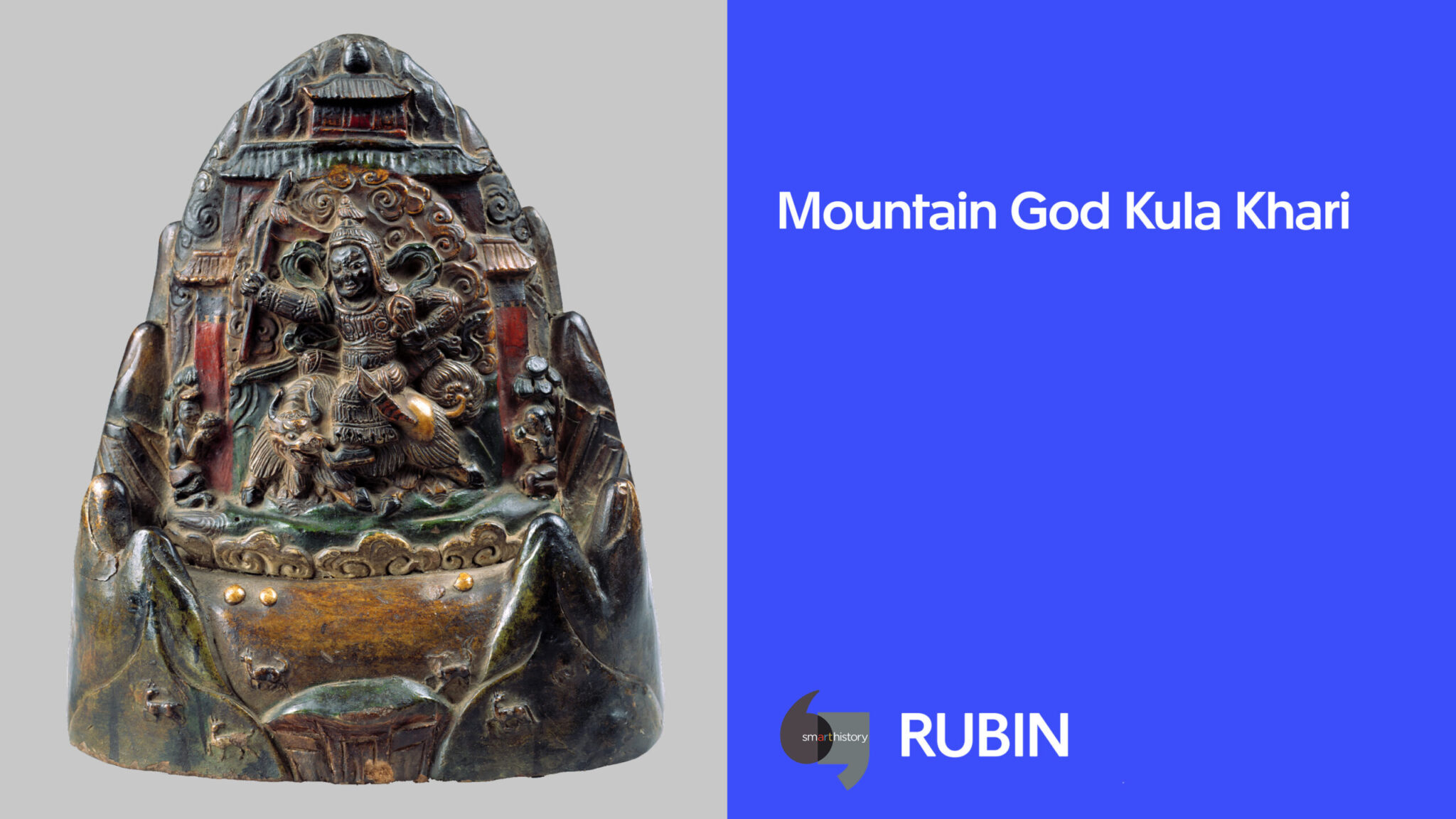
Rubin Museum of Himalayan Art, "Himalayan Art Up Close: Mountain God Kula Khari", YouTube, January 15, 2025, https://youtu.be/tnnZWZR40TA.
This image is also on the front cover of Tony Huber, ed., Sacred Spaces and Powerful Spaces in Tibetan Culture (Dharamsala: Library of Tibetan Works and Archives, 2001).
Youn-mi Kim, “Virtual Pilgrimage and Virtual Geography: Power of Liao Miniature Pagodas (907–1125),” Religions 8, no. 10 (2017): 206–35.
Katja Boertjes, “The Reconquered Jerusalem Represented. Tradition and Renewal on Pilgrimage Ampullae from the Crusader Period,” in The Imagined and Real Jerusalem in Art and Architecture, ed. Jeroen Goudeau, Mariëtte Verhoeven, and Wouter Weijers (Leiden: Brill, 2014), 169–89.
For a description of the process by which a mountain is transformed into a pilgrimage site, see Charles Ramble, “The Creation of the Bon Mountain of Kongpo,” in Mandala and Landscape, ed. Alexander W. Macdonald (Delhi: D. K. Printworld, 1997), 133–232.
“Mkhaʼ Riʼi Las Byang Gsol Kha,” in Dro Bo Bla Mas Nyar Tshags Mdzad Paʼi Dpe Rnying Dpe Dkon, vol. 15, 1283–86, accessed August 20, 2022, http://purl.bdrc.io/resource/MW4PD971_FF5d5E. (paraphrase by the present author).
Françoise Pommaret, ed., Lhasa in the Seventeenth Century: The Capital of the Dalai Lamas, vol. 3, Brill’s Tibetan Studies Library (Leiden: Brill, 2002), 43.
For a more extensive summary of this episode, see Michael Aris, Hidden Treasures and Secret Lives: A Study of Pemalingpa (1450–1521) and the Sixth Dalai Lama (1683–1706) (London and New York: Kegan Paul International, 1989), 54–58.
René de Nebesky-Wojkowitz, Oracles and Demons of Tibet: The Cult and Iconography of the Tibetan Protective Deities, Reprint (Graz: Akademische Druck- u. Verlagsanstalt, 1956), 203.
Joanna Bialek, Compounds and Compounding in Old Tibetan: A Corpus Based Approach (Marburg: Indica et Tibetica Verlag, 2018), 296–301.
For a recent discussion of the cult of the kula in Imperial Tibet, see Nathan W. Hill, “The sku bla Rite in Imperial Tibetan Religion,” Cahiers d ́Extrême-Asie 24 (2015): 49–58.
Per Kvaerne, “The Sku Bla of the Tibetan Emperors—Metamorphosed in Yungdrung Bon?,” in Crossing Boundaries: Tibetan Studies Unlimited, ed. Diana Lange et al. (Prague: Academia Publishing House, 2021), 32–44, which also provides a succinct summary of the debate surrounding the kula class of divinities.
'Jam dpal brtson ’grus, “Sku lha mkha’ ri,” in Lho brag gnas yig, vol. 215–16 (Beijing: Mi rigs dpe skrun khang, 2010), 215.
Tony Huber, Source of Life: Revitalisation Rites and Bon Shamans in Bhutan and the Eastern Himalayas, vol. 1 (Vienna: Verlag der Österreichischen Akademie der Wissenschaften, 2020), 1:402.
Rdzong gsar mkhyen brtse 02 ʼjam dbyangs chos kyi blo gros, “Sku lha mkhaʼ riʼi gsol mchod,” in Gsung ʼbum ʼjam dbyangs chos kyi blo gros, Khyentse Labrang, vol. 11, 2012, 511, http://purl.bdrc.io/resource/MW1KG12986_E61BDE.
Hill, Nathan W. 2015. “The sku bla Rite in Imperial Tibetan Religion.” In “Kingship, Ritual, and Narrative in Tibet and the Surrounding Cultural Area / Royauté, rituel et narration au Tibet et dans l’aire culturelle alentour,” special issue, Cahiers d’Extrême-Asie 24, 49–58.
Huber, Toni, ed. 2001. Sacred Spaces and Powerful Spaces in Tibetan Culture. Dharamsala: Library of Tibetan Works and Archives.
Ramble, Charles. 1997. “The Creation of the Bon Mountain of Kongpo.” In Mandala and Landscape, edited by Alexander W. Macdonald, 133–232. Delhi: D. K. Printworld.
Charles Ramble, “Mountain God Kula Kari: The Mountain Palace of a Worldly Divinity,” Project Himalayan Art, Rubin Museum of Art, 2023, http://rubinmuseum.org/projecthimalayanart/essays/mountain-god-kula-khari.
Lorem ipsum dolor sit amet consectetur adipisicing elit. Cum nihil placeat pariatur deserunt eius ullam incidunt maxime sunt ipsam. Ipsa, provident, laudantium, rem assumenda laboriosam veniam autem voluptas sint officia distinctio enim aut explicabo fuga animi voluptatum earum recusandae excepturi atque dignissimos iste? Exercitationem, praesentium eum. Harum ut maiores expedita exercitationem perspiciatis soluta aperiam dolores natus unde, sequi vitae debitis ex aliquam quas eum reprehenderit esse. Cumque amet et earum necessitatibus, repellendus ullam ducimus corporis architecto culpa placeat eum odit cum iure illo vitae rerum! Ullam et suscipit culpa? Eos voluptatum laudantium iste vero impedit adipisci maxime magni natus voluptatibus.
Get the latest news and stories from the Rubin, plus occasional information on how to support our work.